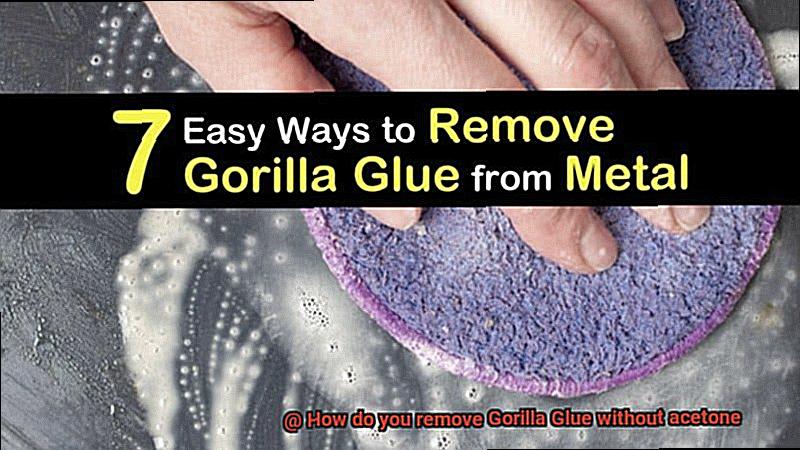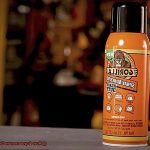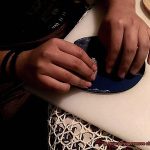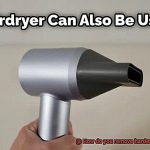Gorilla Glue, the superhero of adhesives, is notorious for its unbeatable bonding abilities. But what happens when you need to part ways with it? Enter acetone, the usual suspect for glue removal. But hey, if acetone isn’t your jam or you simply don’t have any on hand, fret not.
We’ve got your back with alternative methods that can safely dissolve that sticky situation without causing harm to your surfaces.
Get ready for a step-by-step journey where we’ll spill all the secrets on how to bid farewell to Gorilla Glue without relying on acetone. Let’s dive right in and get this glue gone.
What is Gorilla Glue?
Contents
- 1 What is Gorilla Glue?
- 2 Why Acetone is Used to Remove Gorilla Glue
- 3 Alternative Methods to Remove Gorilla Glue without Acetone
- 4 Using Heat to Remove Gorilla Glue
- 5 Using Rubbing Alcohol to Remove Gorilla Glue
- 6 Using Vinegar to Remove Gorilla Glue
- 7 Mechanical Methods for Removing Gorilla Glue without Acetone
- 8 Caution When Removing Gorilla Glue Without Acetone
- 9 Conclusion
Gorilla Glue is a well-known brand of adhesive that is known for its strength and versatility. It is often used for bonding various materials, including wood, metal, ceramic, stone, and more. The glue is made from a polyurethane formula, which gives it unique properties that set it apart from other adhesives on the market.
One of the key features of Gorilla Glue is its incredible strength. It can create a strong and durable bond between surfaces, making it suitable for a wide range of applications. Whether you are repairing broken furniture or working on a craft project, Gorilla Glue can provide a reliable and long-lasting bond.
Another notable characteristic of Gorilla Glue is its waterproof nature. Once cured, the glue is resistant to water and moisture, making it suitable for both indoor and outdoor use. This means that it can be used for projects that will be exposed to water or high humidity without compromising its effectiveness.
In addition to its strength and waterproof properties, Gorilla Glue also expands when it comes into contact with moisture. This expansion helps to fill in gaps and irregularities in the surfaces being bonded, creating an even stronger bond. It also allows the glue to penetrate porous materials more effectively.
It’s important to note that proper application is crucial for achieving the best results with Gorilla Glue. Surfaces should be clean and dry before applying the glue to ensure a strong and effective bond. Additionally, it’s recommended to follow safety precautions when working with Gorilla Glue, such as wearing gloves and protective eyewear.
Why Acetone is Used to Remove Gorilla Glue
When faced with the challenge of removing Gorilla Glue, fear not. There is a mighty solvent that can come to your rescue – acetone. This powerful chemical, commonly found in nail polish removers and paint thinners, possesses incredible abilities to break down and dissolve Gorilla Glue.
Acetone works its magic by penetrating the glue and weakening its bond with the surface. Upon contact with Gorilla Glue, it causes the adhesive to soften and become more pliable. This transformative process makes it easier to scrape or peel off the glue from non-porous surfaces like glass or metal.

However, caution must be exercised when using acetone. Certain materials, such as fabric or painted surfaces, can be sensitive to acetone and may potentially suffer damage or discoloration. To avoid any mishaps, it is always wise to test acetone on a small, inconspicuous area before applying it to the entire surface.
But wait. If acetone isn’t your preferred method of glue removal, fret not. There are alternative approaches and products that can also tackle Gorilla Glue. You can try using heat to soften the adhesive or employ mechanical methods like scraping or sanding. Additionally, specialized adhesive removers designed specifically for Gorilla Glue are available.
Alternative Methods to Remove Gorilla Glue without Acetone
Removing Gorilla Glue without acetone may seem like a daunting task, but fear not. There are alternative methods that can effectively dissolve this powerful adhesive without the use of harsh chemicals.
One method is to harness the power of heat. By using a hairdryer or heat gun on a low setting, you can gently warm up the glue, making it easier to scrape or peel away. Just be cautious not to overheat the surface or apply too much heat, as this may cause damage.
Another option is to use rubbing alcohol. Moisten a cloth or sponge with rubbing alcohol and dab it onto the glued area. Let it sit for a few minutes to allow the alcohol to penetrate and weaken the bond. Afterward, use a plastic scraper or your fingers to peel off the softened glue.
Vinegar is another household item that can come to your rescue. Soak a cloth or paper towel in white vinegar and place it over the glued area. Let it sit for about 30 minutes to an hour, allowing the vinegar’s acidity to break down the adhesive properties of the glue. Then, use a plastic scraper or your fingers to gently scrape off the softened glue.
If you prefer a natural approach, try using olive oil or vegetable oil. Apply a generous amount of oil onto the glued area and let it sit for some time. The oil will gradually dissolve the adhesive properties of the glue, making it easier to remove. Use a plastic scraper or your fingers to gently scrape off the softened glue.
If all else fails, there are commercial adhesive removers available that are specifically designed to tackle strong adhesives like Gorilla Glue. Look for products that do not contain acetone and follow the manufacturer’s instructions carefully.
Remember, when attempting any of these methods, it’s important to be patient and gentle. Avoid using excessive force or harsh chemicals that may damage the surface you are working on. Always test any method or solution on a small, inconspicuous area first to ensure compatibility and avoid potential damage.
Using Heat to Remove Gorilla Glue
Using heat to remove Gorilla Glue can be a safe and effective method, especially if you prefer not to use acetone. By following these step-by-step instructions, you’ll be able to remove the glue without damaging the surface or materials it’s adhered to.
First, gather your materials. You’ll need a hairdryer or heat gun, a plastic scraper or your fingernail for scraping, and a cleaning solution like rubbing alcohol or mild soap.
Start by setting your hairdryer or heat gun to a low heat setting. It’s essential to avoid excessive heat that could potentially damage the surface.
Hold the hairdryer a few inches away from the glue and move it back and forth to evenly distribute the heat. This will help prevent overheating and any potential damage.
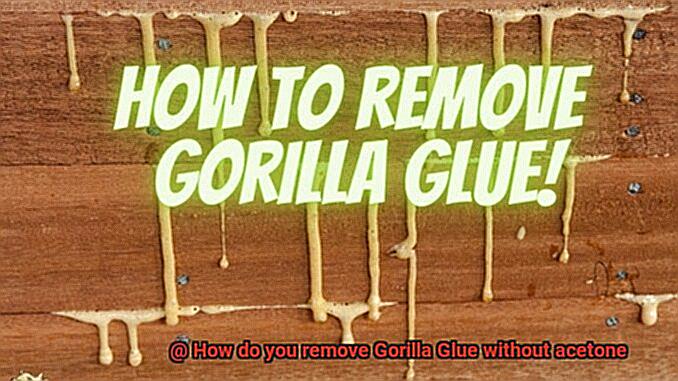
As you apply heat, you’ll notice that the glue begins to soften and become more pliable. This is when you can gently scrape it off using a plastic scraper or your fingernail. Be careful not to scratch or damage the surface while doing this.
If the glue doesn’t come off easily, reapply heat and continue scraping until all the adhesive is removed. It may take some time and effort, but with persistence, you’ll be able to conquer that sticky situation.
After removing the glue, there may still be some residue left behind. Use rubbing alcohol or a mild soap solution to clean the area and remove any remaining adhesive. Remember to test the cleaning solution on a small, inconspicuous area first to avoid damage or discoloration.
Finally, make sure to thoroughly clean the surface with water or a cleaning agent to remove any leftover residue or cleaning agents used.
Using Rubbing Alcohol to Remove Gorilla Glue
Using rubbing alcohol to remove Gorilla Glue is a simple and effective method that can save you from the hassle of using acetone. Here’s a step-by-step guide on how to use rubbing alcohol to remove Gorilla Glue from a surface:
- Gather your supplies: First, you’ll need to gather all the necessary supplies. Make sure you have rubbing alcohol with at least 70% concentration, cotton balls or swabs, a scraper or blunt knife, and warm soapy water. Having these supplies ready will help streamline the process.
- Apply rubbing alcohol: Now it’s time to get started. Take a cotton ball or swab and saturate it with rubbing alcohol. You want it to be damp but not dripping. The alcohol acts as a solvent to break down the adhesive properties of the Gorilla Glue.
- Gently rub the affected area: Begin by gently rubbing the Gorilla Glue with the soaked cotton ball or swab. Apply light pressure and let the rubbing alcohol work its magic. You’ll start to notice the glue softening and becoming easier to remove.
- Scrape away the softened glue: Once the Gorilla Glue has softened, use a scraper or blunt knife to carefully scrape it away. Take your time and be cautious not to damage the surface underneath. If needed, reapply rubbing alcohol and continue scraping until all the glue is removed.
- Clean the area: After successfully removing the Gorilla Glue, it’s important to clean the area thoroughly. Use warm soapy water to wash away any residue left behind. Rinse the area thoroughly and dry it completely.
- Test on a small area first: Before using rubbing alcohol on a larger area, it’s essential to test it on a small, inconspicuous spot. This will help determine if the rubbing alcohol is suitable for your surface and won’t cause any damage or discoloration.
- Be patient and persistent: It’s important to note that rubbing alcohol may not work as quickly or efficiently as acetone, especially for tougher glue stains. Patience and persistence are key when using this method. Don’t give up too soon and keep repeating the process until the glue is fully removed.
- Consider other methods if necessary: If rubbing alcohol doesn’t completely remove the Gorilla Glue, don’t worry. There are other alternative methods you can try. Heat can be effective in softening the glue, so you can use a hairdryer or heat gun to apply heat to the affected area. Mechanical means such as sanding or scraping can also be used as a last resort.
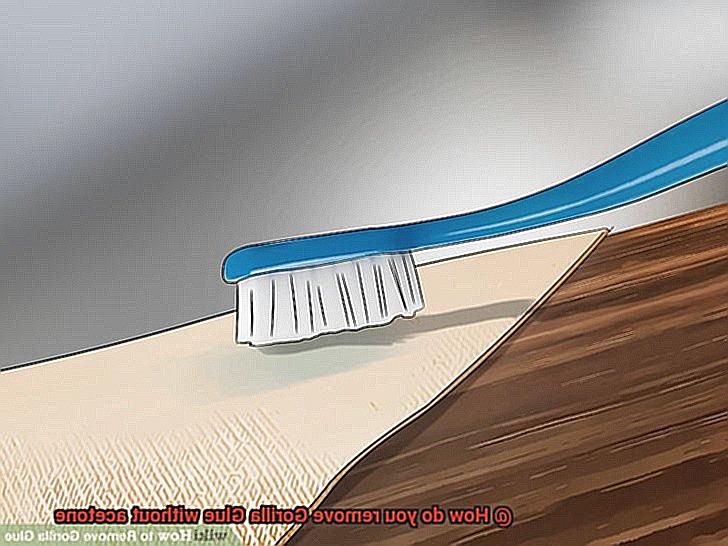
Using Vinegar to Remove Gorilla Glue
When it comes to removing Gorilla Glue, vinegar might not be the first thing that comes to mind. However, this household staple has some surprising adhesive-breaking properties that make it a great option for those who prefer natural and safer alternatives. In this guide, we will walk you through the steps of using vinegar to remove Gorilla Glue effectively.
Supplies Needed:
- White vinegar: A mild acid that can break down the adhesive.
- Clean cloth or sponge: To apply the vinegar onto the glue.
- Warm water: For rinsing.
- Scraper or blunt tool (optional): To gently scrape away the softened glue.
Step-by-Step Process:
- Soak the affected area with vinegar: Pour vinegar directly onto the glue or soak a cloth/sponge in vinegar and apply it to the glue. Ensure the glue is fully saturated.
- Allow vinegar to sit: Let the vinegar sit on the glue for a few minutes. This gives the acid time to react with the adhesive, softening it for easier removal. You might notice some bubbling or foaming as the vinegar works its magic.
- Gently scrape away the softened glue: Using a scraper or blunt tool, carefully scrape away the softened glue. Take care not to damage the surface underneath.
- Repeat if necessary: If some glue remains stubbornly stuck, apply more vinegar and let it sit for a few minutes before attempting to scrape again. Repeat until all of the glue is removed.
- Rinse with warm water: Once you have successfully removed the Gorilla Glue, rinse the area with warm water to remove any remaining vinegar residue.
Dry thoroughly: After rinsing, dry the surface thoroughly to prevent any moisture-related issues.
Important Considerations:
Vinegar may not work on all types of Gorilla Glue, especially if it has fully cured or hardened. In such cases, stronger solvents like acetone may be necessary.
- Test on a small area first: Before applying vinegar to a larger area, it’s essential to test it on a small, inconspicuous spot to ensure it does not cause any damage or discoloration.
- Follow manufacturer instructions: Always follow the instructions and safety precautions provided by the manufacturer of Gorilla Glue or any other adhesive product you are using.
Mechanical Methods for Removing Gorilla Glue without Acetone
Mechanical methods offer a safe and effective alternative to removing Gorilla Glue without the use of acetone or other chemical solvents. These methods require physical action to break down and scrape away the adhesive. Here are some tried-and-true mechanical methods for removing Gorilla Glue:
- Scratching or scraping: Carefully wield a sharp object like a knife or razor blade to delicately scrape away the glue from the surface. Exercise caution and precision to avoid causing any damage to the underlying material. This method works best for smaller areas or thin layers of glue.
- Sanding: Utilize sandpaper or an abrasive sponge to gradually wear down the glue. Begin with a coarse grit sandpaper and progress to finer grits until the glue is completely eradicated. Patience is paramount, as the amount of glue and the treated surface will determine the duration of this method.
- Heat: Apply heat to soften the Gorilla Glue, making it easier to remove. A hairdryer or heat gun can be employed to warm up the glue, which can then be gently scraped off with a knife or other scraping tool. Take care not to overheat or damage the surface in the process.
- Power tools: For more stubborn Gorilla Glue removal, power tools come into play. A drill with a brush attachment or a rotary tool with a sanding accessory can provide additional power and precision, facilitating efficient removal without harming the underlying material.
Caution When Removing Gorilla Glue Without Acetone
Removing Gorilla Glue without acetone can be a challenging task that requires caution and proper safety measures. Gorilla Glue is known for its strong adhesive properties, making it difficult to remove from surfaces without the use of acetone. However, there are instances when acetone may not be an option due to its strong odor, potential hazards, or limited availability. In such cases, it is essential to follow specific guidelines to ensure a safe and effective removal process.
Before attempting to remove Gorilla Glue without acetone, it is crucial to thoroughly read and understand the product label instructions and safety precautions. This knowledge will help you avoid any potential risks and handle the removal process with care. Additionally, it is recommended to work in a well-ventilated area to minimize the inhalation of fumes or vapors from the glue.
To successfully remove Gorilla Glue without acetone, gather all the necessary tools and materials beforehand. This will include items such as a plastic scraper, cotton swabs, warm water, mild soap, and a clean cloth. It is important to note that this process may be time-consuming and may require multiple attempts.
Begin by gently scraping off any excess glue using a plastic scraper or your fingernails. Take care not to scratch or damage the surface underneath. Next, dampen a cotton swab with warm water and gently rub it over the glue. This step can help soften the glue and make it easier to remove.
If the glue remains stubbornly adhered, you can try using a mixture of mild soap and warm water. Apply this solution to the glued area and allow it to sit for a few minutes before attempting to remove the glue again. It is crucial to avoid using excessive force or abrasive materials that could potentially harm the surface. Instead, patience and persistence are key in achieving successful removal.
Once the Gorilla Glue has been successfully removed, thoroughly clean the area with warm water and mild soap to eliminate any residue. However, it is important to note that removing Gorilla Glue without acetone may not guarantee complete removal or restoration of the original surface. Some staining or damage may still be present.
If you are unsure about removing Gorilla Glue without acetone, or if the glue is on a delicate or valuable surface, it is recommended to seek professional assistance or consult the manufacturer for specific recommendations. They can provide guidance tailored to your specific situation and ensure the best possible outcome.
CoNOAlIFCBQ” >
Conclusion
In conclusion, banishing Gorilla Glue without the aid of acetone is indeed possible. While acetone is often the top choice for glue obliteration, there are alternative techniques that can effectively dissolve and eradicate Gorilla Glue sans the use of harsh chemicals. Whether you crave a more natural approach or wish to avoid the pungent odor of acetone, fear not, for options abound.
One such alternative method involves harnessing the power of heat to soften the adhesive. By wielding a hairdryer or heat gun on a low setting, you can gently warm up the glue, rendering it more pliable and amenable to scraping or peeling away. Just exercise caution to prevent overheating or applying excessive heat, as this could potentially wreak havoc on your surface.
Another viable option lies in the realm of rubbing alcohol. Simply moisten a cloth or sponge with this potent elixir and dab it onto the glued area. Allow it to marinate for a few minutes, permitting the alcohol to infiltrate and weaken the bond. Afterward, employ either a plastic scraper or your nimble fingers to delicately peel off the softened glue.
Vinegar stands tall as yet another household hero capable of coming to your rescue. Soak a cloth or paper towel in white vinegar and drape it over the beleaguered area. Grant it thirty minutes to an hour for the vinegar’s acidic might to dismantle the adhesive properties of Gorilla Glue. Then let loose with either a plastic scraper or your deft digits to gingerly scrape off that now-softened glue.
For those who prefer an all-natural approach, consider calling upon olive oil or vegetable oil for aid. Slather on copious amounts of these slippery saviors and allow them time to work their magic. The oils will diligently dissolve Gorilla Glue’s adhesive tendencies bit by bit until removal becomes child’s play. Once again, arm yourself with a plastic scraper or your nimble fingers to gently scrape off the softened glue.
Should all else fail, take solace in knowing that commercial adhesive removers specifically designed to tackle formidable foes like Gorilla Glue do exist. Seek out products that boast an acetone-free formula and carefully adhere to the instructions provided by their manufacturers.
Remember, when embarking upon any of these methods, patience and gentleness are key. Eschew excessive force or harsh chemicals that may inflict damage upon your beloved surface.

